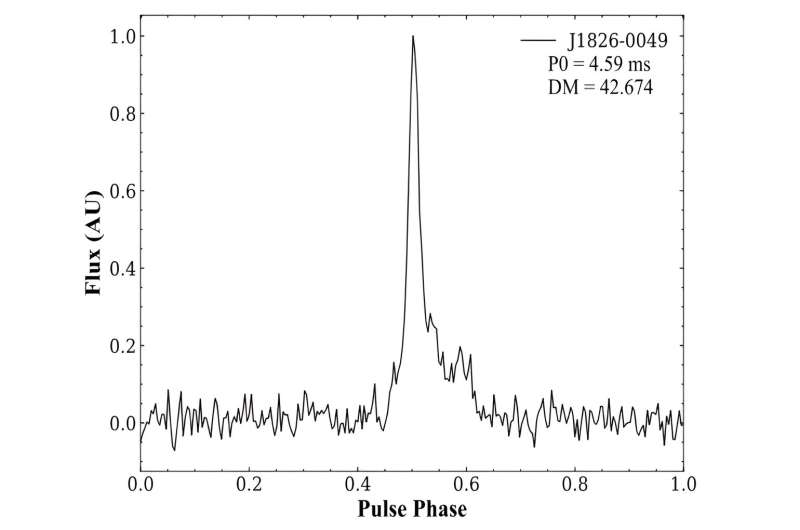November 8, 2023 report
This article has been reviewed according to Science X's editorial process and policies. Editors have highlighted the following attributes while ensuring the content's credibility:
fact-checked
preprint
trusted source
proofread
Five new pulsars discovered with FAST

Using the Five-hundred Aperture Spherical Telescope (FAST), astronomers from China and Australia have discovered five new pulsars, two of which turned out to have ultra-short spin periods. The finding was reported in a research paper published November 1 on the preprint server arXiv.
Pulsars are highly magnetized, rotating neutron stars emitting a beam of electromagnetic radiation from their magnetic poles. This radiation can only be observed when the beam of emission is pointing toward the Earth.
The most rapidly rotating pulsars, with rotation periods below 30 milliseconds, are known as millisecond pulsars (MSPs). It is assumed that they are formed in binary systems when the initially more massive component turns into a neutron star that is then spun up due to accretion of matter from the secondary star.
Now, a team of astronomers led by Qi-Jun Zhi of the Guizhou Normal University in Guiyang, China, reports the detection of five new pulsars with FAST as part of a pilot survey at intermediate Galactic latitudes.
"With 13.5 hours of observing time that covers 4.7 square degrees of area, we discovered five new pulsars and detected all six known pulsars in this region," the researchers explained.
The newfound pulsars received designations PSR J1826−0049, PSR J1852+1200, PSR J1837+0419, PSR J1849+1001 and PSR J1839+0543. Two of these pulsars, namely PSR J1826−0049 and PSR J1852+1200 turned out to be MSPs with spin periods of 4.59 and 3.86 milliseconds, respectively.
PSR J1849+1001 and PSR J1839+0543 were classified as "mildly-recycled" pulsars with massive white dwarf companions (with minimum masses of about 0.87 solar masses). When it comes to PSR J1837+0419, it appears to be an isolated normal pulsar with a spin period of 504.74 milliseconds.
The detected pulsars have dispersion measures ranging from 42.67 to 174.75 pc/cm3. The researchers also measured the surface magnetic field strength of PSR J1826−0049, PSR J1849+1001 and PSR J1837+0419, which was found to be 0.33, 1.3 and 840 billion Gauss, respectively. The characteristic ages of these three pulsars were estimated to be 3 billion, 11.5 billion, and 5.9 million years, respectively.
Summing up the results, the authors of the paper noted that observing facilities like FAST of the Parkes radio telescope have a huge potential to uncover the presence of even hundreds of new millisecond pulsars.
"In order to assess the potential yield of MSPs, we conducted population simulations and found that both FAST and Parkes new Phased Array Feed surveys, focusing on intermediate Galactic latitudes, have the capacity to uncover several hundred new MSPs," the researchers concluded.
More information: Q. J. Zhi et al, Discovery of five pulsars in a pilot survey at intermediate Galactic latitudes with FAST, arXiv (2023). DOI: 10.48550/arxiv.2311.00370
Journal information: arXiv
© 2023 Science X Network





















